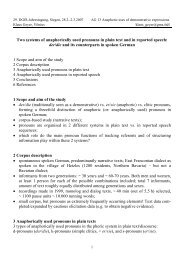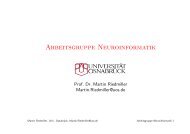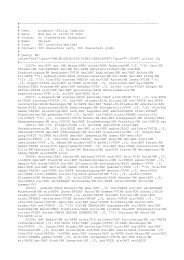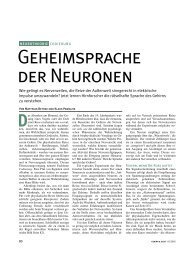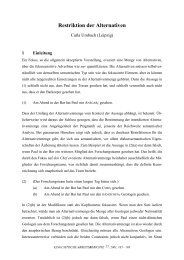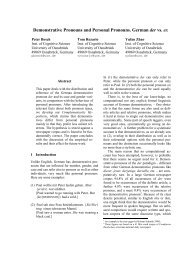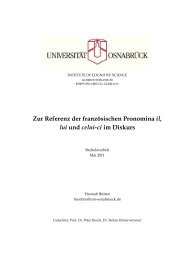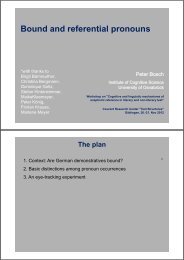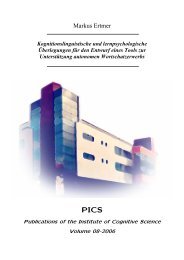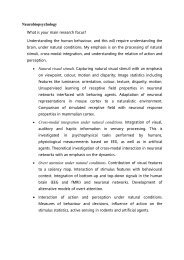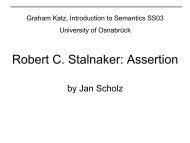- Page 1: Sinn & Bedeutung Proceedings of the
- Page 4 and 5: ISSN: 1610-5389 Series title: Publi
- Page 7 and 8: Program Sunday, October 07 18.30 -
- Page 9: Wedneday, October 10 09.45 - 10.30
- Page 12 and 13: Peter Krause PRESUPPOSITION JUSTIFI
- Page 14 and 15: The contrast between (2) and (3) is
- Page 16 and 17: strings has a meaning roughly equiv
- Page 20 and 21: We find that sgan-ei ve-tat-ei aluf
- Page 22 and 23: examples. Rather, the contrast is a
- Page 24 and 25: Indeed, if the deletion rule has no
- Page 26 and 27: (49) schei- en natuurkunde ‘chemi
- Page 29 and 30: NON-DYNAMIC ANALYSES OF ANAPHORIC P
- Page 31 and 32: (5) a. Exactly one boy left school
- Page 33 and 34: exploited. That is, one would expec
- Page 35 and 36: (17) At the Seattle demonstration,
- Page 37 and 38: (24) a. John is politically naive a
- Page 39 and 40: We get an account of cases such as
- Page 41: 5 Conclusion There is quite strong
- Page 44 and 45: individuals: F2 ∈ P (P (E2 )) and
- Page 46 and 47: devoted to answer these questions.
- Page 48 and 49: Corollary 2 (Non-reducibility) If a
- Page 50 and 51: In diesem Beitrag soll gezeigt werd
- Page 52 and 53: (4) Verben, die sowohl sein- als au
- Page 54 and 55: Diese Beispiele zeigen, dass nicht
- Page 56 and 57: (11) Positionsverben sitzen, liegen
- Page 58 and 59: Während in c. Klangemission ausged
- Page 60 and 61: Für die in diesem Abschnitt behand
- Page 62 and 63: Des Weiteren kommt bleiben in Verbi
- Page 64 and 65: Literatur Abraham, W. 1993. Ergativ
- Page 66 and 67: terms of present-day English) betwe
- Page 68 and 69:
Another puzzle raised by ‘bleachi
- Page 70 and 71:
sentence to “make things fit”.
- Page 72 and 73:
. [[ to see the doctor ]] = x e ( S
- Page 74 and 75:
The present tense, however, makes a
- Page 76 and 77:
We can easily turn (49a) and (49d)
- Page 78 and 79:
I can only propose a preliminary an
- Page 81 and 82:
VERBS IN CONCEPTUAL SPACE ∗ Wilhe
- Page 83 and 84:
a. b. c. d. hue blue bright transpa
- Page 85 and 86:
2.2 Data Reduction is Possible As a
- Page 87 and 88:
geometric approach is that it prese
- Page 89 and 90:
y comparing the different variants
- Page 91 and 92:
direction null "steigen" "klettern"
- Page 93 and 94:
suspect that all these verbs in fac
- Page 95:
verbs like ‘climb’, we ultimate
- Page 98 and 99:
In section 2, we examine our backgr
- Page 100 and 101:
(5) John called somebody. I wonder
- Page 102 and 103:
CP projected by S2, the discourse r
- Page 104 and 105:
3. *(JBB): John revised John’s pa
- Page 106 and 107:
ut it does not eliminate all but on
- Page 108 and 109:
Judgements are unclear for (37). Th
- Page 110 and 111:
[Kehler, 2000] Andrew Kehler. Coher
- Page 112 and 113:
extensional, model-theoretic interp
- Page 114 and 115:
AFF: C-Role - Affected Object AFF:
- Page 116 and 117:
“(Julia [FACT real] realized)[FAC
- Page 118 and 119:
motivates the denotation “Multila
- Page 120 and 121:
tells nothing.”). In this case, t
- Page 122 and 123:
4.2 NatLink - The Semantic Interpre
- Page 124 and 125:
Gnörlich, Carsten (2002). Technolo
- Page 127 and 128:
RELATIVE SPECIFICITY * Klaus von He
- Page 129 and 130:
epistemic specific indefinite, and
- Page 131 and 132:
Jackendoff (1972) investigates spec
- Page 133 and 134:
3 Grammatical encoding of specifici
- Page 135 and 136:
indicated to William of Baskerville
- Page 137 and 138:
5 Semantic theories of specificity
- Page 139 and 140:
domain or box, while referential te
- Page 141 and 142:
(52) William didn’t see a book. (
- Page 143:
Kamp, Hans 1981. A Theory of Truth
- Page 146 and 147:
is some other referent in the disco
- Page 148 and 149:
. Der Koch hat selbst schon mal Bla
- Page 150 and 151:
. Hannes hat seinen Sohn gebeten, s
- Page 152 and 153:
positions of -self. The crucial not
- Page 154 and 155:
Semantically, the following is assu
- Page 156 and 157:
latedness relation available for th
- Page 158 and 159:
of cake-baking. The way the agent/s
- Page 160 and 161:
c. Ich habe gestern sein (*selbst)
- Page 162 and 163:
Siemund, Peter (2000b) ‘Towards a
- Page 164 and 165:
In this paper we propose to use the
- Page 166 and 167:
a transitive, serial and Euclidean
- Page 168 and 169:
¨ Because is anti-symmetric, the
- Page 170 and 171:
3.4 Implicit belief To continue wit
- Page 172 and 173:
In all the examples discussed so fa
- Page 174 and 175:
?ϕ ?ψ ϕ ψ ϕ ψ ϕ ψ ϕ ψ ϕ
- Page 176 and 177:
¤ ¥ ¢ ¥ ¤ ¥ ¥ ¤ ¥ ¢ Pro
- Page 178 and 179:
is typically used in the context of
- Page 181 and 182:
TENSE SELECTION AND THE TEMPORAL IN
- Page 183 and 184:
elieve-will. This reflects the intu
- Page 185 and 186:
(12) a. At noon, Monika believed th
- Page 187 and 188:
So if in the above scenario Fritz
- Page 189 and 190:
If (25) can be interpreted at all i
- Page 191 and 192:
Von Stechow assumed that tense oper
- Page 193 and 194:
elieve we need only abstract over t
- Page 195 and 196:
References Abusch, Dorit (1988). Se
- Page 197 and 198:
ADJECTIVES IN CONSTRUCT * Ji-yung K
- Page 199 and 200:
The CSA complement is invariably un
- Page 201 and 202:
Secondly, the definiteness of the e
- Page 203 and 204:
3.3 CSAs are Adjectives Finally, ju
- Page 205 and 206:
predicate which modifies an individ
- Page 207 and 208:
(7) a. na’ara [yefat eynayim me
- Page 209 and 210:
. a song-and-dance band [Partee, p.
- Page 211 and 212:
I think this is related to the ques
- Page 213 and 214:
METAPHORISCHE UND METONYMISCHE MUST
- Page 215 and 216:
Im Folgenden soll es nun vor allem
- Page 217 and 218:
die sich im Unterschied zu (iia) au
- Page 219 and 220:
Außerdem können auch sogenannte i
- Page 221 and 222:
In diesen Fällen liegt eine Intens
- Page 223 and 224:
(17) a. Es war ekelhaft kalt. b. Ic
- Page 225 and 226:
nen, liegt ein metonymisches Muster
- Page 227:
(vii) Nicht-A A Nicht-GPA 215 GPA 4
- Page 230 and 231:
give guidance to neuroscientific re
- Page 232 and 233:
easonable hypotheses about how the
- Page 234 and 235:
established perspective within cogn
- Page 236 and 237:
chosen as a function of the grammar
- Page 238 and 239:
(iii) for which A and B share a lex
- Page 240 and 241:
4 Neural Computation In this paper
- Page 242 and 243:
A computer model of this kind, thou
- Page 245 and 246:
GROUPS AND SHEAVES Marcus Kracht II
- Page 247 and 248:
operation n that takes n arguments
- Page 249 and 250:
assuming that it presupposes a deci
- Page 251:
Fortunately, (30) is not a good cou
- Page 254 and 255:
While universal presuppositions for
- Page 256 and 257:
(8) No publisher discontinues his f
- Page 258 and 259:
QC1,C P 2 where Q ranges over indef
- Page 260 and 261:
x1 man(x1) fat(x1) push(x1,δ x2 bi
- Page 262 and 263:
The initial formalization of the se
- Page 264 and 265:
Like in the fat man example, there
- Page 266 and 267:
Heim, I.: 1983, On the projection p
- Page 268 and 269:
what the proponents of a uniform an
- Page 270 and 271:
splitting-up of E with respect to t
- Page 272 and 273:
Perfective aspect. The clause speci
- Page 274 and 275:
phonous eventive sentence. The foll
- Page 276 and 277:
participle and the auxiliary, [verb
- Page 278 and 279:
The phenomenon has often been taken
- Page 280 and 281:
(19) Bevor sie nach Hause gekommen
- Page 282 and 283:
schon past imperfective (24) Sie fr
- Page 284 and 285:
As to the problematic temporal clau
- Page 287 and 288:
MAXIMALITY AND MINIMALITY IN COMPAR
- Page 289 and 290:
(4) [the d: Jim is d-fast] > MAXfd:
- Page 291 and 292:
consider universal quantifiers. 2.2
- Page 293 and 294:
embedded necessity operator are und
- Page 295 and 296:
How could we capture a suitable ord
- Page 297 and 298:
ordering source in (35). (35) 8w,w
- Page 299:
. 8t[t< YESTERDAY ) [the d: itwasd-
- Page 302 and 303:
The main goal of this paper is to c
- Page 304 and 305:
are not the same: In the first game
- Page 306 and 307:
of expected utility. To get some in
- Page 308 and 309:
With this modified utility function
- Page 310 and 311:
Since Lewis introduced his signalli
- Page 312 and 313:
4.3 Lewis on conventional signallin
- Page 314 and 315:
t: t R1 R2 S1 1 0 S2 1 0 S3 0.5 0.5
- Page 316 and 317:
eing evolutionary stable: it might
- Page 318 and 319:
Noble (2000) has recently given an
- Page 320 and 321:
more general stability concept for
- Page 322 and 323:
[24] Rooy, R, van (2001), ‘Conver
- Page 324 and 325:
PMA Manner Modification Adverbs È
- Page 326 and 327:
(8) a. *Everything smoothly was run
- Page 328 and 329:
to the clausal reading of the tempo
- Page 330 and 331:
3 Implications for the formal appar
- Page 332 and 333:
From these sentence representations
- Page 334 and 335:
4.4 Using syntax in choosing the ap
- Page 337 and 338:
ON THE TRUTH CONDITIONAL POTENTIAL
- Page 339 and 340:
a car did Peter buy The present pap
- Page 341 and 342:
The structure tree (9) shows the sy
- Page 343 and 344:
5 Semantic mechanism of mapping The
- Page 345 and 346:
topical DP. From this operation res
- Page 347 and 348:
(b) lambda-application: λP λℜ
- Page 349 and 350:
The discourse-embedding feature [+T
- Page 351 and 352:
which is mapped onto referential co
- Page 353 and 354:
Krifka, M. (1998) Scope Inversion u



